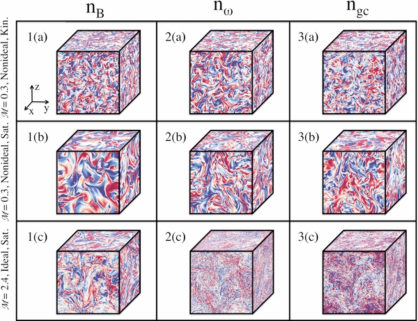2014 Annual Science Report
 Arizona State University
Reporting | SEP 2013 – DEC 2014
Arizona State University
Reporting | SEP 2013 – DEC 2014
Astrophysical Controls on the Elements of Life - Task 5 - Model the Variability of Elemental Ratios Within Clusters
Project Summary
We carried out studies of self-enrichment of the earliest star clusters. Building on the turbulence simulations in Pan & Scannapieco (2010) and Pan et al. (2011), we examined the mixing of heavy elements generated by stars into the surrounding cluster environments.
Project Progress
From Sep. 1 2013-Dec 31 2014 we carried out two studies of the mixing of enriched gas into a magnetized medium, as occurs when heavy elements generated by stars are mixed into their surrounding cluster environments. In this situation, turbulence has two important effects: first, turbulent motions build up large concentration gradients, which allow molecular diffusion to mix materials at the smallest scales; second, they wind-up magnetic fields and greatly increase their magnitude, through a process known as the small-scale dynamo. These simulations focused on how turbulent mixing depends both on the magnetic Prandtl number, the ratio of fluid viscosity to magnetic resistivity, and the turbulent Mach number, the ratio of the root-mean-squared turbulent velocity to the sound speed.
In Sur, Pan, & Scannapieco (2013), we conducted a suite of large, massively parallel simulations, obtaining several important results related to the mixing of the heavy elements generated by stars. For subsonic flows, we found that the velocity power spectrum had a -5/3 slope in the early kinematic phase, but steepened due to magnetic backreactions as the field saturated. The scalar power spectrum, on the other hand, flattened compared to -5/3 at late times, consistent with the classic picture of mixing as a cascade process, known as the Obukohov–Corrsin phenomenology. At higher Mach numbers, the velocity power spectrum also steepened, due to the presence of shocks, and the scalar power spectrum flattened accordingly.
Furthermore, we found that scalar structures were arranged in sheets in both the kinematic and saturated phases of magnetic field evolution, for all values of Prandtl number and Mach number. The most important results of this study, however, were measurements of the overall mixing rate, as this rate directly determines the homogeneity of star forming regions. Over the full parameter suite spanned by the simulations, we found that magnetic fields dramatically slowed this mixing rate, implying that forming star clusters are more chemically inhomogeneous than modeled in simulations that ignore the impact of magnetic fields.
In a second study, Sur, Pan, Scannapieco, (2014), we were able to explain the origin of this strong suppression of mixing. By measuring the direction of the magnetic field, the vorticity field, and the scalar gradient field, he showed that at all times chemical gradients were strongly biased perpendicular to the magnetic field direction. Surprisingly, this was true both early on, when the magnetic field was negligible, and at late times, when the field was strong enough to back-react on the flow. Through detailed analysis, we found that the reason that the scalar gradient was perpendicular to the magnetic field, as well as the vorticity field, was due to the fact that they all arose from the strain tensor of the turbulent motions.

Publications
-
Sur, S., Pan, L., & Scannapieco, E. (2014). ALIGNMENT OF THE SCALAR GRADIENT IN EVOLVING MAGNETIC FIELDS. The Astrophysical Journal, 790(1), L9. doi:10.1088/2041-8205/790/1/l9
-
Sur, S., Pan, L., & Scannapieco, E. (2014). MIXING IN MAGNETIZED TURBULENT MEDIA. The Astrophysical Journal, 784(2), 94. doi:10.1088/0004-637x/784/2/94
-
PROJECT INVESTIGATORS:
-
PROJECT MEMBERS:
Evan Scannapieco
Project Investigator
Liubin Pan
Collaborator
-
RELATED OBJECTIVES:
Objective 1.1
Formation and evolution of habitable planets.
Objective 3.1
Sources of prebiotic materials and catalysts